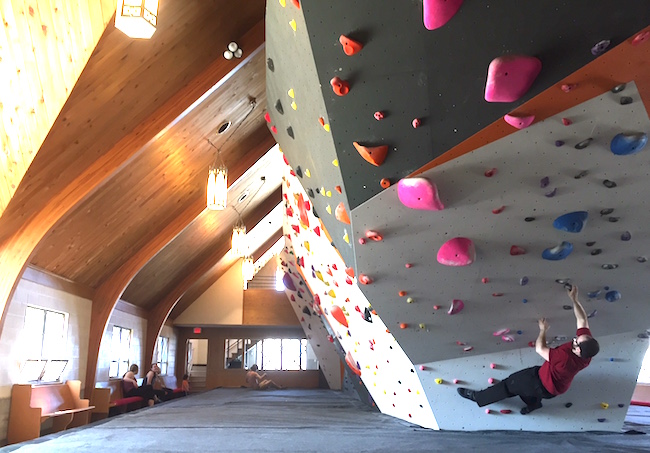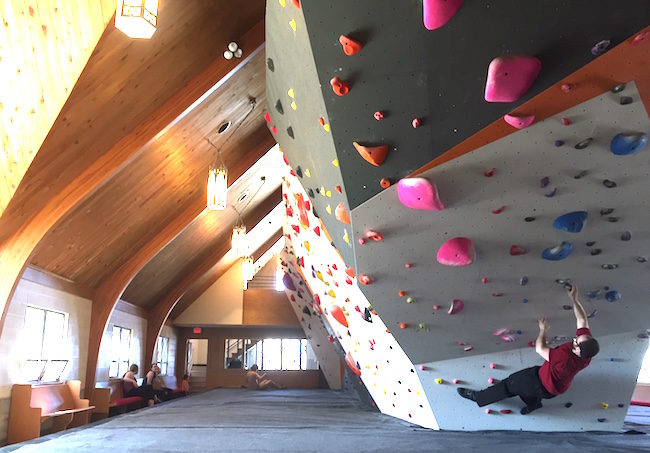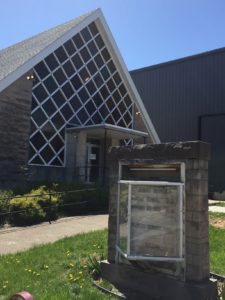

By John Burgman
Because of indoor climbing’s popularity over the past several years, many gyms have settled on a prevailing development model: an adequate plot of land is found, an expansive facility is constructed, and the space is garnished with myriad new features like yoga studios, weight rooms, and gear shops. Developers have utilized this model to great success, both in building gyms from the ground up and in replacing older ones.
However, substantial spatial requirements for a gym are comparable to those in other industries—such as processing, packaging, and warehousing. This means that there are repurposing opportunities for developers who might prefer to use an old building rather than erect a new one. These older, preexisting spaces often make for a unique aesthetic and distinguished character when given a climbing makeover.
Such was the case in Bloomington, Indiana, a city whose location—first as a train stop for the limestone industry in the 19th century, and then as a home for religious revivals in the early 1900s—provided it with many buildings in desperate need of restoration.
Just a few hours from Red River Gorge, Bloomington has been home to a close-knit climbing community for decades. But when the city’s preeminent gym, Hoosier Heights, announced to its patrons that it was looking to move to a more prominent location near the bustling downtown, an unlikely option emerged:
“There was literally a big FOR SALE sign near the street—a church was being sold, and it happened to be in a good location in an area that’s up-and-coming with young professionals settling in,” says Tristan Stahl, the manager of Hoosier Heights’ Bloomington facility. “The congregation of this church had sort of aged itself out. Most people going there were elderly, and the church was actually moving locations anyway. So, I think there was an opportunity to make something truly unique and radically different.”
Radically different is an appropriate description—the gym that would eventually be created within the Methodist church’s historic exterior after a massive 16-month renovation would be unlike anything the Midwest. There were gym amenities inserted into the church building—nearly 20,000 square feet of climbing space, an upstairs MoonBoard nook, and a yoga room. But certain important features, such as a baptismal pool in the sanctuary and pews in the church’s lounge, were kept for posterity. A parish library that formerly stored bibles and hymnals was filled with decades’ worth of back issues of climbing magazines.

A Mix of the Old and New
Blending the design of a church that had been built in 1925 with the contemporary features of a modern gym was challenging for the renovation crew—both literally and figuratively.
“When I first walked through the church, I was really excited,” recalls Stahl. “But when it was time to actually start clearing things out, I realized how involved a process it would be to renovate an old building. There were areas in the church’s roof that were bad, and the electric [wiring] was bad. We had to move out all the old office stuff, and we had to move all the big filing cabinets. It was more challenging than just buying a plot of land, building a steel structure, and putting a climbing gym in it.”
While the preservation of the ornate interior and the addition of climbing walls would give patrons a distinctive climbing experience, significantly altering the architecture was an aspect of the reformation that was nonnegotiable: the church had previously been deemed a historic building by the city, which limited the structural alterations that could be made during the renovation. For example, additions to the building were never to exceed the church’s preexisting height. The original ceiling, flooring (with the addition of 16-inch open cell foam), and stained glass windows were also kept in the makeover.
But preserving much of the church’s original appearance was also part of an unofficial promise made with the community to maintain the integrity of the old space.
“There were other [developers] who bid on the church,” says Stahl. “But we basically won over the neighbors by saying that we were going to keep a lot of the church’s character. And for a lot of [the congregation], it was sad to leave this church—where they had spent years of their lives. So, we tried to be as accommodating as possible, to keep the structure the way it was and to not alter it too much.”
Another aspect that was retained from the building’s original iteration was a degree of fellowship—no longer of a religious nature, but attuned now to a reality that many people turn to their local gym for more than just climbing.
Stahl says, “We wanted to create a space where people could come to climb, but also to study or to do homework or to just hang out all day. Especially with millennials, the work schedule and where someone works doesn’t really matter anymore—so we’re trying to feed into that.”
A large percentage of Hoosier Heights’ membership draws from nearby Indiana University, which boasts more than 100,000 students. The new gym, closer to campus and boasting a much larger lounge for patrons, allows for a continued partnership with the school in the form of Introduction to Indoor Climbing as well as Intermediate Indoor Climbing classes for college credit. Groups from the university’s Living Learning Centers and rec clubs also frequent the gym.
The church’s uniqueness also helps with visibility: “We’re seeing a lot of people now who are on their way home from work, or on their way to class, or just walking by stop in to check us out,” Stahl says. “We have some members who do a lot of photo editing—and one of them was just in here all day to work in the lounge—didn’t even climb, just came to work on some editing.”
Downtown Accessibility
The aesthetic aspect that Stahl mentions is practically unavoidable when gyms retrofit climbing to older facilities—and there are a number of other examples. The Stronghold in Los Angeles was a reimagining of an Edison Electric Company steam power plant building from the early 1900s. And Ascend Pittsburg, adorned with elongated windows, exists in a space that was formerly a Duquesne Brewery bottling facility until the mid 20th century.
“Windows aren’t really a revenue stream, but when people are here, it makes them feel really comfortable, and it’s a cool experience to be able to get a panoramic view of all of a city,” says Paul Guarino, Ascend Pittsburgh’s director of marketing and human resources. The Pennsylvania gym totals 27,000 square feet and offers an assortment of bouldering, cardio, and yoga. Like Hoosier Heights in Bloomington, Ascend Pittsburgh has also honed in on the “lounging” angle, offering snacks and free WiFi.
Guarino notes that Ascend Pittsburgh’s existence in an older building was also partly a matter of circumstance; being in the downtown, rather than in the suburbs, was an important aspect of the gym’s development—and any city, by nature, is limited in empty, spacious lots but abundant with old buildings that can be leased.
“I come from the restaurant industry, and that industry is famous for this model of creating a new business in an old space—especially in a city,” Guarino says, noting that a former bottling facility in the heart of a city also has an advantage of being multi-accessible, drawing on bike and bus commuters, as well as foot traffic that the suburbs simply might not have. And, as was the case with Ascend Pittsburgh, the landlords of under-utilized city buildings are often excited to have a new and meaningful business revitalize an old space.
“Lease conversations [in the city] always start with whether the space is going to be used as an office or a retail or commercial space. But a climbing gym is kind of none of those and all of those at the same time—and they can pay tribute to the history of a city,” says Guarino. “I would love to retrofit more old buildings for climbing.”

John Burgman is the author of High Drama, a book that chronicles the history of American competition climbing. He is a Fulbright journalism grant recipient and a former magazine editor. He holds a master’s degree from New York University and bachelor’s degree from Miami University. In addition to writing, he coaches a youth bouldering team. Follow him on Twitter @John_Burgman and Instagram @jbclimbs. Read our interview Meet John Burgman, U.S. Comp Climbing’s Top Journalist.






